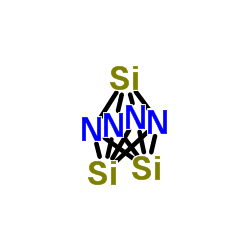氮化硅

氮化硅结构式

|
常用名 | 氮化硅 | 英文名 | Silicon nitride |
|---|---|---|---|---|
| CAS号 | 12033-89-5 | 分子量 | 140.283 | |
| 密度 | 2.8±0.1 g/cm3 | 沸点 | N/A | |
| 分子式 | N4Si3 | 熔点 | 1900 °C | |
| MSDS | 中文版 美版 | 闪点 | N/A |
|
K(+) , Na(+) , and Mg(2+) on DNA translocation in silicon nitride nanopores.
Electrophoresis 33(23) , 3448-57, (2012) In this work, we report on how salt concentration and cation species affect DNA translocation in voltage-biased silicon nitride nanopores. The translocation of dsDNA in linear, circular, and supercoiled forms was measured in salt solutions containing KCl, NaC... |
|
|
Fabrication and characterization of nanopores with insulated transverse nanoelectrodes for DNA sensing in salt solution.
Electrophoresis 33(23) , 3488-96, (2012) We report on the fabrication, simulation, and characterization of insulated nanoelectrodes aligned with nanopores in low-capacitance silicon nitride membrane chips. We are exploring these devices for the transverse sensing of DNA molecules as they are electro... |
|
|
Quantitative probing of surface charges at dielectric-electrolyte interfaces.
Lab Chip 13(7) , 1431-6, (2013) The intrinsic charging status at the dielectric-electrolyte interface (DEI) plays a critical role for electrofluidic gating in microfluidics and nanofluidics, which offers opportunities for integration of wet ionics with dry electronics. A convenient approach... |
|
|
Microfluidic devices for X-ray studies on hydrated cells.
Lab Chip 13(2) , 212-5, (2013) X-ray studies of biological cells in microfluidic devices provide a method to probe cellular structures or structural changes at the molecular level in a precisely controlled environment. However, the device design and the used materials must be compatible wi... |
|
|
Protein adsorption and covalent bonding to silicon nitride surfaces modified with organo-silanes: comparison using AFM, angle-resolved XPS and multivariate ToF-SIMS analysis.
Colloids Surf. B Biointerfaces 110 , 217-24, (2013) Organo-silanes provide a suitable interface between the silicon-based transducers of various biosensing devices and the sensing proteins, immobilized through physical adsorption, as for (3-aminopropyl)triethoxysilane (APTES), or covalent binding, e.g. via pro... |
|
|
Nanopore-spanning lipid bilayers on silicon nitride membranes that seal and selectively transport ions.
Langmuir 29(14) , 4421-5, (2013) We report the formation of POPC lipid bilayers that span 130 nm pores in a freestanding silicon nitride film supported on a silicon substrate. These solvent-free lipid membranes self-assemble on organosilane-treated Si3N4 via the fusion of 200 nm unilamellar ... |
|
|
Voltage-driven translocation of DNA through a high throughput conical solid-state nanopore.
PLoS ONE 7(9) , e46014, (2012) Nanopores have become an important tool for molecule detection at single molecular level. With the development of fabrication technology, synthesized solid-state membranes are promising candidate substrates in respect of their exceptional robustness and contr... |
|
|
High throughput fabrication of plasmonic nanostructures in nanofluidic pores for biosensing applications.
Nanotechnology 23(41) , 415304, (2012) One of the primary advantages of nanoscale sensors is that they often can provide conceptually new ways of performing sensing that are not feasible with their large-scale analogs. For example, the small size of nanoscale sensor elements, such as plasmonic met... |
|
|
Third-harmonic UV generation in silicon nitride nanostructures.
Opt. Express 21(2) , 2012-7, (2013) We report on strong UV third-harmonic generation from silicon nitride films and resonant waveguide gratings. We determine the absolute value of third-order susceptibility of silicon nitride at wavelength of 1064 nm to be χ(³) (-3ω,ω,ω,ω) = (2.8 ± 0.6) × 10⁻²⁰... |
|
|
Visualizing nanoparticle mobility in liquid at atomic resolution.
Chem. Commun. (Camb.) 49(29) , 3007-9, (2013) Gold nanorods are widely known for their photothermal properties to treat solid tumors. Our work demonstrates the unrealized capacity to image these reagents in liquid at high resolution using Transmission Electron Microscopy (TEM). Here we perform the first ... |